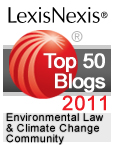The Green False Claim Most Companies Are Making Without Realizing It
You are a good green company. You have dutifully installed a solar array on your facility, and use the energy it produces to power your manufacturing process.
You proudly proclaim on your website, in your SEC filing or on your product packaging that you "use renewable energy." You calculate your Carbon Footprint and deduct the emissions that would have been generated using conventional fuel.
If, like most companies, you have sold the renewable energy credits (RECs) attributable to the renewable energy, you will potentially be in violation of Section 5 of the FTC Act (15 U.S.C. Sec. 45) (“Section 5”), which prohibits “deceptive acts or practices in or affecting commerce.”
The Federal Trade Commission released the long-awaited fourth edition of the "Green Guides" on October 11, 2012. The purpose of the Guides is to provide a framework for companies to truthfully and non-deceptively market environmental and “green” products, packages, and services. A copy of the Guides is available here.
The Guides address green marketing in general and specific applications, including renewable energy (Section 260.15). In one of the more controversial aspects of the Guides, the FTC advises that:
If a marketer generates renewable electricity but sells the renewable energy certificates for all of that electricity, it would be deceptive for the marketer to represent, directly or by implication, that it uses renewable energy.
Guides at § 260.15(d).
The FTC has concluded that renewable energy stripped of its carbon reduction and other environmental benefits is just energy. Thus, even if a company has a renewable energy installation on its facility, and uses the energy from that facility to power its manufacturing process, if it sells the renewable energy credits, it still would not be able to represent that it used renewable energy. In addition, any carbon offsets or emissions reductions could not be included in the company's calculation of its environmental impact.
This counter-intuitive result was roundly criticized in comments on the Guides:
Most commenters agreed that it would be deceptive for a marketer to represent that it uses renewable energy if it sold all the renewable attributes of the energy it uses. Most who addressed this issue, however, disagreed with the Commission’s proposed guidance. They argued that, even when a firm sells RECs, it should be able to market its role in generating renewable energy.
The FTC, in its response, defended its position regarding RECs, but said that a company hosting a renewable energy facility and selling the RECs would not be violating the FTC Act if it describes fully and accurately its role in the transaction. Most companies, however, are not doing this.
There is some evidence that the FTC is increasing its enforcement of false environmental claims. The FTC brought claims against four national retailers, including Amazon, Macy’s and Sears, that were allegedly selling textiles as made of bamboo when they were actually made of rayon. The companies settled with the FTC on or about January 3, 2013, paying a total of $1.26 million in penalties for the false advertising.
The FTC brought claims against Sherwin Williams and PPG for deceptively marketed their paints as free from volatile organic compounds (VOCs). According to the FTC, the base paints were VOC free, but tinted paint (which most customers buy) contained VOCs. The FTC settled the claims in October, 2012, and the companies were forced to change their marketing practices.
Given the frequency with which the Renewable Energy/REC rule is broken, it would be impossible for the FTC to police all of the violators. However, In the context of other green marketing claims, the FTC may scrutinize a companies' representations about renewable energy and greenhouse gas reductions. For companies that make public disclosures in Securities and Exchange Commission filings, this could be of even greater concern.

 Shari focuses on energy, environmental and building code policy, representing international companies, non-profits and trade associations in their policy and communications campaigns
Shari focuses on energy, environmental and building code policy, representing international companies, non-profits and trade associations in their policy and communications campaigns

